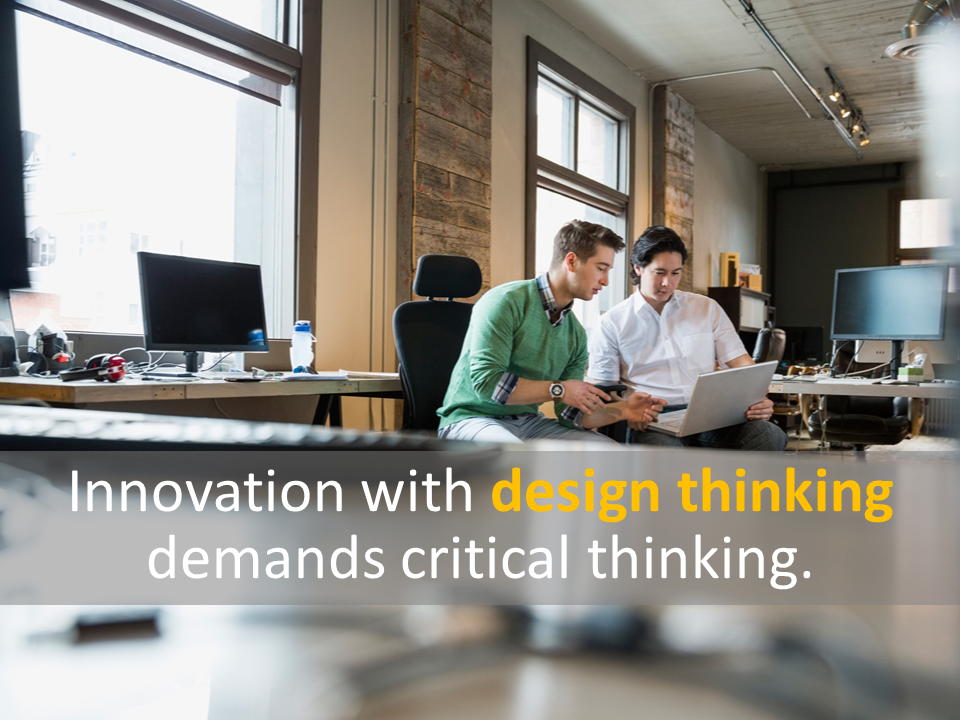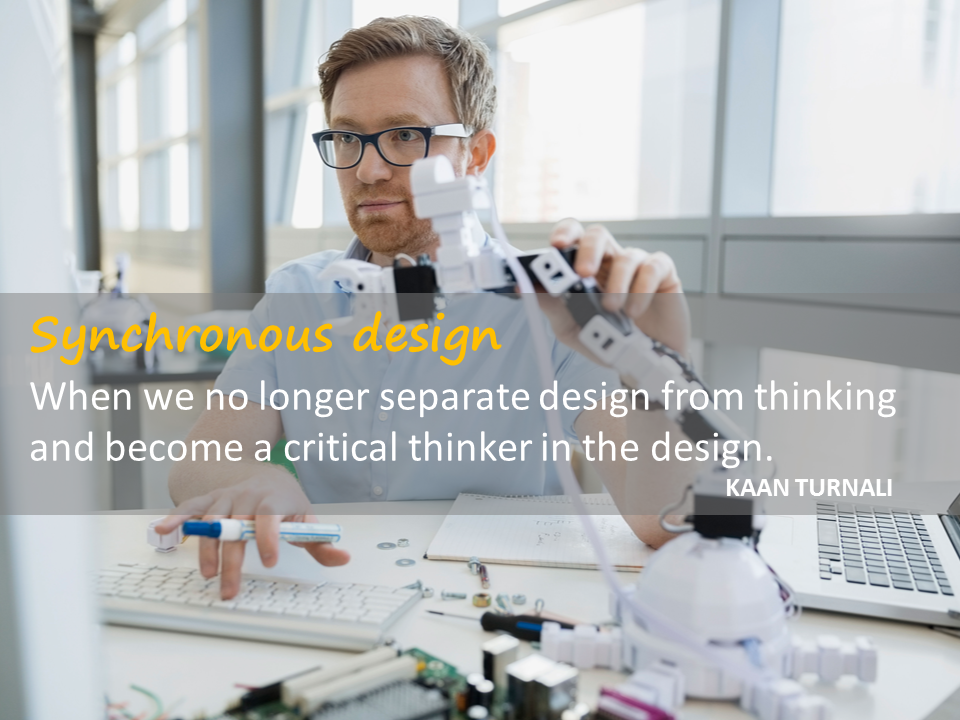
- SAP Community
- Groups
- Interest Groups
- Application Development
- Blog Posts
- Innovation With Design Thinking Demands Critical T...
Application Development Blog Posts
Learn and share on deeper, cross technology development topics such as integration and connectivity, automation, cloud extensibility, developing at scale, and security.
Turn on suggestions
Auto-suggest helps you quickly narrow down your search results by suggesting possible matches as you type.
Showing results for
former_member18
Participant
Options
- Subscribe to RSS Feed
- Mark as New
- Mark as Read
- Bookmark
- Subscribe
- Printer Friendly Page
- Report Inappropriate Content
08-24-2016
6:56 PM

Innovation with design thinking demands critical thinking because we must understand our assumptions that frame our ideas and shape our design.
As our world becomes more and more digital, it’s not the first click that counts – it’s what happens after that first click. We design five steps ahead in the user experience, not one. And to deliver integrated solutions with a holistic view, we analyze five dimensions and drop none. By blending design thinking with critical thinking, we foster innovation that delivers customer-centric solutions.
This mindset is crucial to the success of design thinking because its universal applications are a key driver for creating opportunities for both new and old solutions, no matter if they are internal- or customer-facing.
Here are three reasons why innovation with design thinking demands critical thinking.
Critical thinking does not hinder–but rather augments–innovative thinking
Some people believe that critical thinking hampers innovative thinking and, therefore, consider it as incompatible with design thinking. This notion is misleading and relies on the misinterpreted assumption of what critical thinking means and how it applies to design.
There is nothing in the design-thinking process that prohibits the ability to challenge consensus or pursue alternative views. Instead, it encourages us to observe a complete view of the user experience and paint an accurate picture of reality.
Critical thinking is a key ingredient in evaluating and improving our ideas, regardless of how we label them. It should not be confused with being argumentative. If used effectively, critical thinking can help us acquire vital insight about the user experience and strengthen our design assumptions.
Innovation with design thinking demands critical thinking because we must understand our assumptions that frame our ideas and shape our design.
Let’s take this a step further. When we seek to design and deliver innovative solutions, it’s not enough to just have new or creative ideas. To drive growth and profitability, the new or creative ideas have to be useful and relevant. Critical thinking provides a vigorous and crucial perspective when evaluating these ideas and transforming them when necessary.
Design thinking is the art of mindful restraint
 Exhibiting mindful restraint is at the heart of design thinking because it eliminates conscious and unconscious bias. This is especially important when it comes to empathy. The more knowledge we enjoy and the more credentials someone has, the more assumptions we may make. If these assumptions are left untested or remain unfiltered, the solutions built on them risk failure when presented or consumed by actual users.
Exhibiting mindful restraint is at the heart of design thinking because it eliminates conscious and unconscious bias. This is especially important when it comes to empathy. The more knowledge we enjoy and the more credentials someone has, the more assumptions we may make. If these assumptions are left untested or remain unfiltered, the solutions built on them risk failure when presented or consumed by actual users.Critical thinking gives us the tools to remove perceived success. This capability is especially important as we become more critical, not less, when examining our own assumptions. When we design, our human instincts crave validation based on our prior knowledge, justification of our prior decisions, and support of earlier conclusions or beliefs. In the process, we may deny ourselves the opportunity to design inside-out—rather than outside-in.
Find invaluable insights hidden in plain sight
Invaluable insight is best discovered in areas hidden from plain sight. When critical thinking blends with design thinking, we not only design human-centered models for understanding the problem, but also present alternative ways of looking at a problem.
Similarly, to identify and understand the logical connection between each idea, we should become active design thinkers, not passive recipients of information. Through critical thinking, we are encouraged to rigorously question ideas and assumptions, rather than accepting them without deeper reflection. In turn, design thinkers apply critical thinking to determine whether their ideas and findings represent a realistic picture of the user experience.
Bottom line

From my experience, “asynchronous design,” as I call it, is restrictive because it is typically formed through separate steps in a “design and think” or “think and design” approach. Instead, design must be viewed as a “synchronous” process, where we observe the situation and identify needs and opportunities while applying thinking that thoroughly represents the reality of our intended target users. With synchronous design, we no longer separate design from thinking; we become a critical thinker in the design.
Critical thinking helps us break down assumed models taken for granted by the status quo. By eliminating artificial structures that are inherent in traditional approaches, we foster design thinkers who are encouraged to identify new opportunities for innovation in all roles and at all levels of the enterprise.
By systematically cultivating our talent, we promote, what I call, a growth philosophy in design that says: “Don’t just teach me design thinking–show me how to think in the design.” And that’s how we compete on design thinking to drive growth and profitability.
Stay tuned for the next installment of the Design Thinking thought leadership series!
Connect withme on Twitte (@KaanTurnali), LinkedIn and turnali.com.
DESIGN THINKING SERIES
- What is Design Thinking?
- Competing on Design Thinking
- An Obsession With Customer-Centric Innovation
- The Art & Science of Customer Empathy
- Critical Thinking
- Design Thinking Is About Integrated Solutions
This post first appeared on turnali.com
More from Business Trends:
- Run Simple: Leadership, Talent, And A Culture Of Innovation
- 4 Ways We Can Redefine Innovation In The Enterprise
- 3 Reasons Why Thought Leadership Matters
- How Do You Define Business Talent?
- 5 Tools That Foster Technology Innovation
- Leadership Starts With One
- Single-Click Consultants Need Not Apply
- 5 Reasons Why More Data Doesn’t Guarantee Better Decisions
- 4 Reasons Why Excellent Customer Service Should Start With A Smile
- SAP Managed Tags:
- Digital Technologies,
- Design Thinking
You must be a registered user to add a comment. If you've already registered, sign in. Otherwise, register and sign in.
Labels in this area
-
A Dynamic Memory Allocation Tool
1 -
ABAP
8 -
abap cds
1 -
ABAP CDS Views
14 -
ABAP class
1 -
ABAP Cloud
1 -
ABAP Development
4 -
ABAP in Eclipse
1 -
ABAP Keyword Documentation
2 -
ABAP OOABAP
2 -
ABAP Programming
1 -
abap technical
1 -
ABAP test cockpit
7 -
ABAP test cokpit
1 -
ADT
1 -
Advanced Event Mesh
1 -
AEM
1 -
AI
1 -
API and Integration
1 -
APIs
8 -
APIs ABAP
1 -
App Dev and Integration
1 -
Application Development
2 -
application job
1 -
archivelinks
1 -
Automation
4 -
BTP
1 -
CAP
1 -
CAPM
1 -
Career Development
3 -
CL_GUI_FRONTEND_SERVICES
1 -
CL_SALV_TABLE
1 -
Cloud Extensibility
8 -
Cloud Native
7 -
Cloud Platform Integration
1 -
CloudEvents
2 -
CMIS
1 -
Connection
1 -
container
1 -
Debugging
2 -
Developer extensibility
1 -
Developing at Scale
4 -
DMS
1 -
dynamic logpoints
1 -
Eclipse ADT ABAP Development Tools
1 -
EDA
1 -
Event Mesh
1 -
Expert
1 -
Field Symbols in ABAP
1 -
Fiori
1 -
Fiori App Extension
1 -
Forms & Templates
1 -
General
1 -
Getting Started
1 -
IBM watsonx
1 -
Integration & Connectivity
10 -
Introduction
1 -
JavaScripts used by Adobe Forms
1 -
joule
1 -
NodeJS
1 -
ODATA
3 -
OOABAP
3 -
Outbound queue
1 -
Product Updates
1 -
Programming Models
13 -
Restful webservices Using POST MAN
1 -
RFC
1 -
RFFOEDI1
1 -
SAP BAS
1 -
SAP BTP
1 -
SAP Build
1 -
SAP Build apps
1 -
SAP Build CodeJam
1 -
SAP CodeTalk
1 -
SAP Odata
1 -
SAP UI5
1 -
SAP UI5 Custom Library
1 -
SAPEnhancements
1 -
SapMachine
1 -
security
3 -
text editor
1 -
Tools
17 -
User Experience
5
Top kudoed authors
| User | Count |
|---|---|
| 5 | |
| 3 | |
| 2 | |
| 2 | |
| 2 | |
| 2 | |
| 2 | |
| 1 | |
| 1 |